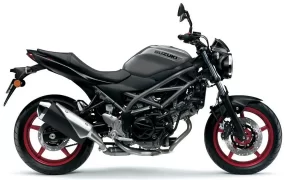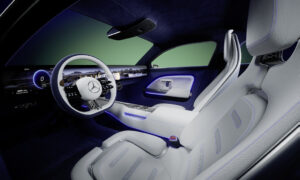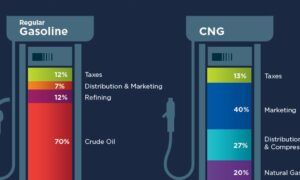We installed a set of improved brakes for our 2022 Honda Civic Si after 10,000 miles in preparation for some track days.

Update on 10,000 Miles
Over 13,000 miles of road trips and commutes have replaced the new-car fragrance with fast-food aromatherapy, but the team still admires our long-term Honda Civic Si enough to desire more from it. While the 11th-generation Civic continues to eat up miles without incident, lurgy, or katzenjammer (put down the thesaurus before someone gets knackered), there are a few places where we believe it might use some additional ketchup.
We’ve been looking for aftermarket parts to take the Civic Si to the next level. Its brakes went full quasar on our new stopping test from 100 mph. The braking system’s warning light illuminated due to the high temperatures, and we suffered substantial brake fade. Although not a typical situation under regular driving circumstances (unless you routinely drive at 100 mph), it was a clear area for development before attending forthcoming track days.

Nobody offered improved brake pads for the brand-new 2022 Si until recently. Despite using the same calipers and pads as the current Accord, track-grade gear in the family sedan market is about as frequent as baby formula at a Piggly Wiggly right now. So we’re dealing with the problem the way most Honda Civic owners do: DIY-style.
Last to brake, first to finish
We sought assistance from Mike Puskar, proprietor of Carbotech Performance Brakes. He promised us that his track pads would transform the Si’s braking performance from stepping in something nasty to stepping on something powerful. Mike brought us to Carbotech’s Concord, North Carolina, manufacturing plant to create our own set.

Carbotech has been helping racing vehicles brake later with their high-temp ceramic Kevlar friction compound since 1996. The majority of pads offered now are semi-metallic or ceramic compounds that are not intended for track usage. Carbotech’s pads vary in temperature capabilities from 800 degrees Fahrenheit in the ordinary street compound to 2000 degrees Fahrenheit in racing pads. Each pad is handcrafted by a seasoned brake-ologist at Carbotech.
Pads for our Civic Si weren’t yet available, but Carbotech stated it could make them using the OE hardware to construct the backplate templates. (We wish all prospective 11th-generation Civic Si owners a fantastic track day.)

We were ecstatic when our Honda Civic Si arrived at Car and Driver HQ to begin its 40,000-mile stay. We want to wring as much enjoyment as possible out of this inexpensive sports car over the next 52 weekends or thereabouts. So far, this has included traveling to Florida for an IMSA Endurance Cup race at Sebring and brushing up against cones at an SCCA autocross event. It’s the start of what we hope to be an intriguing long-term test.
The Civic Si’s options list is as limited as its shift time from first to second gear. The Blazing Orange Pearl ($395) hue is exclusive to the Si and matches the color of our favorite Buffalo Wild Wings sauce (Spicy Garlic). We also went for the High-Performance Tire option ($200), which covers the 18-by-8.0-inch rims in grippy Goodyear Eagle F1 Asymmetric 2 rubber. We saved $1708 by choosing the black basic wheels rather the optional blade-style wheels, which we intend to replace with an aftermarket set later. Your greatest (or most hilariously terrible) recommendations are welcome in the Car and Driver inbox.
Honda put our favorite sport compact on hold for a year and killed the coupe completely. The Si, thankfully, has returned as a longer, lower, broader, and more serious-looking sedan. Visually, the Civic Si has progressed from Gundam Wing to adult, approaching the maturity and size of the Accord. The inside has been greatly improved, with a larger 9.0-inch touchscreen, temperature control knobs with digital readouts, and a comfortable firm grip region. Every Si has the identical red-and-black textile inside, although its equipment is mostly the same as the Civic Touring, excluding the leather. The new Si’s upgrades have resulted in a $2120 price hike, and for that much, we wish it still had heated seats like the previous vehicle.
Unfortunately, the new Civic Si does not have a more powerful engine. The turbocharged 1.5-liter inline-horsepower four’s has reduced from 205 to 200, but its 192 pound-feet of torque comes 300 rpm sooner. Despite losing five horsepower, our long-term vehicle equaled the previous-generation Civic Si sedan’s 6.6-second sprint to 60 mph and even matched its 14.9-second quarter-mile at 95 mph. However, in our top-gear passing-time calculations, the new Si demonstrates that lower torque peak with a 2.2-second-quicker time from 30 to 50 mph and a 0.1-second-quicker run from 50 to 70 mph. Overall, most people won’t notice much of a change by the seat of their trousers, but the car’s great handling and driving make us wish the Si had a few more horses.

With fewer than 6000 miles on the odometer, the logbook is already filling up with notes on the sporty suspension, which is turning out to be a love/hate relationship. The stronger suspension, chassis, and performance tires on the Si may make for a bumpy ride over Michigan’s plethora of expansion joints and uneven (and sometimes absent) pavement. “Not the most relaxing commuter,” one editor observed. “Stiff suspension + morning coffee = ruined shirt,” senior features editor Greg Fink observed.
The adaptive dampers that came standard on the previous Si are not available on this model. Instead, the new Integra A-Spec, which is effectively an Acura-badged Civic Si with leather seats, gets that kit. There is no comfort option for our aged backs and expanding buttocks here.

The three driving modes—Normal, Sport, and Individual—do not significantly alter the Si. Sport mode modifies steering weight and throttle responsiveness while turning off the stop-start feature. It’s a pity this setting doesn’t bring more personality to the Si’s fairly silent twin mufflers. Individual setting combines Sport steering with Normal throttle responsiveness. The stop-start feature may also be turned off at any moment using a separate button from the driving modes. Honda has added a rev-matching system to the Civic Si, which was previously only available on the Civic Type R. This may be a bit inconvenient to activate or disable since it’s done via the infotainment touchscreen under vehicle settings, which can only be accessible with the parking brake engaged.
The Civic Si boasts a number of increasingly unusual features: It’s a sedan that only comes with a six-speed manual gearbox, and its rumbling is powered by prohibited apple juice. It’s worth celebrating that it’s still accessible. We’re glad it’s back, ushering in the 11th generation since the original Civic debuted in the 1970s. So, before the Civic Si is replaced by a crossover, we’ve got 40,000 kilometers to go and more cones to kill.
2 months in the fleet Mileage as of today: 5977 miles
Fuel Economy: 29 mpg on average
Fuel Tank Capacity: 12.4 gal Observed Range: 350 miles
Repair: $0 Service: $0 Normal Wear: $0
$0 in Damage and Destruction

READ MORE- the 2022 BSA Gold Star will be available soon after delays.



